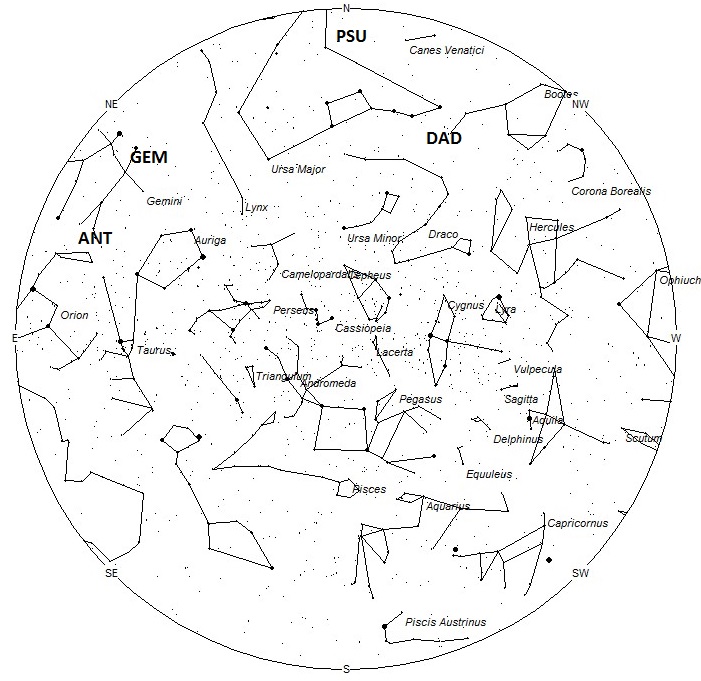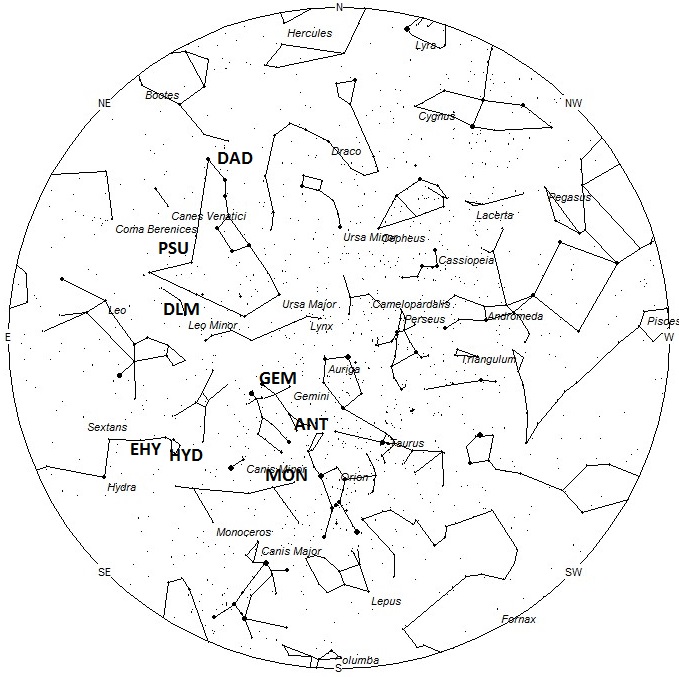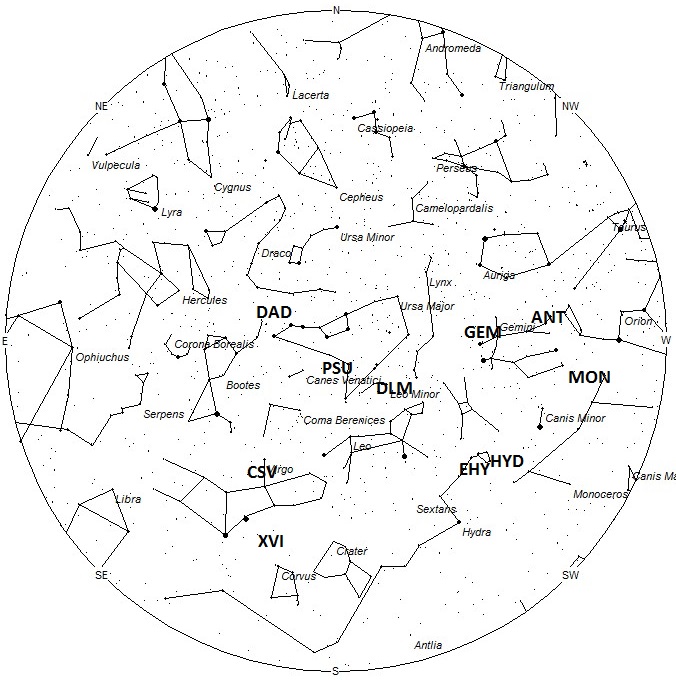During this period the moon reaches its full phase on Tuesday December 13th. At this time the moon will be located opposite the sun and will lie above the horizon all night long. This weekend the waxing gibbous moon will set between 0200 and 0300 on Saturday morning and 0300 and 0400 on Sunday morning, allowing a couple of hours of meteor viewing under dark skies before the start of dawn. The estimated total hourly meteor rates for evening observers this week is near 4 as seen from mid-northern latitudes (45N) and 2 as seen from tropical southern locations (25S). For morning observers the estimated total hourly rates should be near 33 as seen from mid-northern latitudes (45N) and 23 as seen from tropical southern locations (25S). Evening rates are reduced during this period due to the bright moonlight. The actual rates will also depend on factors such as personal light and motion perception, local weather conditions, alertness and experience in watching meteor activity. Note that the hourly rates listed below are estimates as viewed from dark sky sites away from urban light sources. Observers viewing from urban areas will see less activity as only the brightest meteors will be visible from such locations.
The radiant (the area of the sky where meteors appear to shoot from) positions and rates listed below are exact for Saturday night/Sunday morning December 10/11. These positions do not change greatly day to day so the listed coordinates may be used during this entire period. Most star atlases (available at science stores and planetariums) will provide maps with grid lines of the celestial coordinates so that you may find out exactly where these positions are located in the sky. A planisphere or computer planetarium program is also useful in showing the sky at any time of night on any date of the year. Activity from each radiant is best seen when it is positioned highest in the sky, either due north or south along the meridian, depending on your latitude. It must be remembered that meteor activity is rarely seen at the radiant position. Rather they shoot outwards from the radiant so it is best to center your field of view so that the radiant lies at the edge and not the center. Viewing there will allow you to easily trace the path of each meteor back to the radiant (if it is a shower member) or in another direction if it is a sporadic. Meteor activity is not seen from radiants that are located below the horizon. The positions below are listed in a west to east manner in order of right ascension (celestial longitude). The positions listed first are located further west therefore are accessible earlier in the night while those listed further down the list rise later in the night.
These sources of meteoric activity are expected to be active this week.
Now that the activity from particles produced by comet 2P/Encke have ceased encountering the Earth, the Taurid showers for 2016 are over and we resume reporting activity from the Anthelion (ANT) radiant. This is not a true radiant but rather activity caused by the Earth’s motion through space. As the Earth revolves around the sun it encounters particles orbiting in a pro-grade motion that are approaching their perihelion point. They all appear to be radiating from an area near the opposition point of the sun, hence the name Anthelion. These were once recorded as separate showers throughout the year but it is now suggested to bin them into their category separate from true showers and sporadics. There are several lists that have the Chi Orionids currently active, but we include them with the Anthelions as the celestial positions overlap. This radiant is a very large oval some thirty degrees wide by fifteen degrees high. Activity from this radiant can appear from more than one constellation. The position listed here is for the center of the radiant which is currently located at 06:16 (091) +23. This position lies in western Gemini, at the position occupied by the 4th magnitude star known as 1 Geminorum. Anthelion activity may appear from eastern Taurus, northeastern Orion, southern Auriga as well as western Gemini. This radiant is best placed near 0100 local standard time (LST) when it lies on the meridian and is highest in the sky. Rates at this time should be near 2 per hour as seen from the northern hemisphere and less than 1 per hour from south of the equator. With an entry velocity of 30 km/sec., the average Anthelion meteor would be of slow velocity.
The Monocerotids (MON) are active from a radiant located at 06:45 (101) +08. This position lies in northern Monoceros, 5 degrees south of the 3rd magnitude star known as Xi Geminorum. Current rates should be near 1 per hour no matter your location. The Monocerotids are best seen near 0100 LST when the radiant lies highest above the horizon. At 41 km/sec. the Monocerotids produce mostly meteors of medium velocity.
The Geminids (GEM) reach maximum activity on Tuesday morning December 13. Unfortunately the glare of the full moon will reduce rates by at least 75%. At maximum the radiant is located at 07:33 (113) +32. This position lies in northern Gemini, just northwest of the 2nd magnitude star known as Castor (Alpha Geminorum). Rates this weekend should be good, especially between moonset and dawn. These meteors are best seen from mid-northern latitudes down to the equator. Any further south than that and rates will decline due to the lower radiant altitude. The radiant is best placed near 0200, when it lies highest above the horizon. At 34 km/sec. the Geminids produce mostly meteors of medium velocity. There should also be many Geminid fireballs visible Sunday through Wednesday.
The sigma Hydrids (HYD) are active from November 26 through December 21, with maximum activity occurring on December 6. The radiant is currently located at 08:32 (128) +02, which places it in western Hydra, just west of the small circular group of stars that form the head of Hydra. These meteors are best seen near 0300 LST when the radiant lies highest above the horizon. Current rates should be near 2 per hour no matter your location. With an entry velocity of 61 km/sec., most activity from this radiant would be of swift speed.
The eta Hydrids (EHY) were recently discovered by members of of the Croatian Meteor Network. This radiant is active from December 09-17 with maximum activity occurring on December 11. The radiant is currently located at 09:08 (137) +02 , which places it in western Hydra, 1 degree west of the 4th magnitude star known as theta Hydrae. This position is close to that of the sigma Hydrids so care must be taken to separate the two sources. These meteors are best seen near 0400 LST when the radiant lies highest above the horizon. Current rates should be near 1 per hour no matter your location. With an entry velocity of 63 km/sec., most activity from this radiant would be of swift speed.
The December Leonis Minorids (DLM) are a shower of long duration active from December 6th through January 18th. Maximum occurs near December 21st when rates may reach 3 an hour. During this period I would expect an hourly rates of near 1 from a radiant located at 10:16 (154) +33. This position lies in central Leo Minor, 3 degrees east of the faint star known as 21 Leo Minoris. These meteors are best seen near 0500 LST when the radiant lies highest above the horizon. At 63 km/sec. the December Leonis Minorids produce mostly swift meteors. These meteors are not well seen from the southern hemisphere.
The Psi Ursa Majorids (PSU) were discovered by the Japanese observers using data from SonotaCo. These meteors are active from December 1-16 with maximum occurring on December 4th. The radiant is currently located at 11:40 (175) +41, which places it 7 degrees southeast of the 3rd magnitude star known as Psi Ursae Majoris. These meteors are best seen during the last dark hour before dawn, when the radiant lies highest above the horizon in a dark sky. Rates would most likely be less than 1 per hour. At 63 km/sec. the Psi Ursa Majorids produce mostly swift meteors.
The December chi Virginids (XVI) was discovered by Japanese observers using the data of SonotaCo. This source is active from December 8-24 with maximum activity occurring on the 16th. The current radiant location is at 12:39 (190) -09, which places it in south-central Virgo, near the spot occupied by the faint star known as chi Virginis. This is a rather blank part of the sky and the easiest way to find the radiant is to draw a line from Porimma (Gamma Virginis) to Algorab (Alpha Corvi). Half-way between these two fairly bright stars is close to the radiant. Current rates would most likely be less than 1 shower member no matter you location. These meteors are best seen during the last dark hour before dawn, when the radiant lies highest above the horizon in a dark sky. At 69 km/sec. the December Chi Virginids would produce mostly swift meteors.
The December sigma Virginids (DSV) was discovered by John Greaves using the data of SonotaCo. IMO video cameras confirmed that this source is active during most of December. Visual observers have their best chance at catching these meteors from December 17-30. Peak rates occur near December 24th. The current radiant location is at 13:13 (198) +06 which places it in northern Virgo 1 degree northwest of the faint star known as sigma Virginis. Current hourly rates would be less than 1 shower member no matter you location. These meteors are best seen during the last dark hour before dawn, when the radiant lies highest above the horizon in a dark sky. At 68 km/sec. the December Sigma Virginids would produce mostly swift meteors.
The December alpha Draconids (DAD) were discovered by the Japanese observers using data from SonotaCo and is active from December 5-18. They were predicted to peak on December 7th. The radiant is currently located at 13:52 (208) +58. This position actually lies in northeastern Ursa Major, 5 degrees northeast of the second magnitude star known as Mizar (Zeta Ursae Majoris). These meteors are best seen during the last dark hour before dawn, when the radiant lies highest above the horizon in a dark sky. This shower is not well seen from the southern hemisphere. Current rates would most likely be less than 1 per hour no matter your location. Recent analysis by the IMO has revealed that this shower actually has two activity periods. The one listed above and another lasting from December 26-January 1st.
As seen from the mid-northern hemisphere (45N) one would expect to see approximately 11 sporadic meteors per hour during the last hour before dawn as seen from rural observing sites. Evening rates would be near 2 per hour. As seen from the tropical southern latitudes (25S), morning rates would be near 8 per hour as seen from rural observing sites and 1 per hour during the evening hours. Locations between these two extremes would see activity between the listed figures.
| SHOWER | DATE OF MAXIMUM ACTIVITY | CELESTIAL POSITION | ENTRY VELOCITY | CULMINATION | HOURLY RATE | CLASS |
| RA (RA in Deg.) DEC | Km/Sec | Local Standard Time | North-South | |||
| Anthelion (ANT) | – | 06:16 (091) +23 | 30 | 01:00 | 2 – 1 | II |
| Monocerotids (MON) | Dec 09 | 06:45 (101) +08 | 41 | 01:00 | 1 – 1 | II |
| Geminids (GEM) | Dec 13 | 07:33 (113) +32 | 34 | 02:00 | 15 – 10 | I |
| sigma Hydrids (HYD) | Dec 07 | 08:32 (128) +02 | 61 | 03:00 | 2 – 2 | II |
| eta Hydrids (EHY) | Dec 12 | 09:08 (137) +02 | 63 | 04:00 | 1 – 1 | IV |
| Dec. Leonis Minorids (DLM) | Dec 20 | 10:16 (154) +33 | 63 | 05:00 | 1 – <1 | II |
| psi Ursa Majorids (PSU) | Dec 05 | 11:40 (175) +41 | 61 | 07:00 | <1 – <1 | IV |
| Dec. chi Virginids (XVI) | Dec 17 | 12:39 (190) -09 | 69 | 08:00 | <1 – <1 | IV |
| Dec. sigma Virginids (DSV) | Dec 24 | 13:13 (198) +06 | 68 | 09:00 | <1 – <1 | IV |
| Dec. alpha Draconids (DAD) | Dec 07 | 13:52 (208) +58 | 41 | 10:00 | <1 – <1 | IV |




